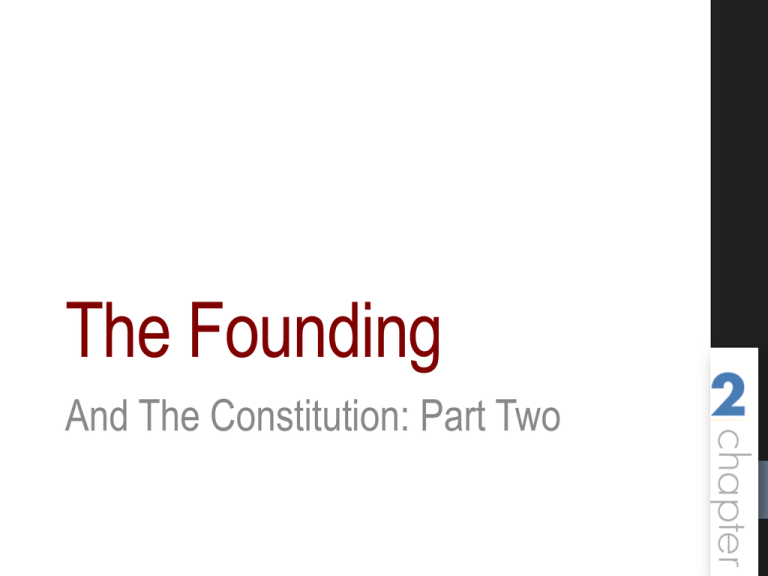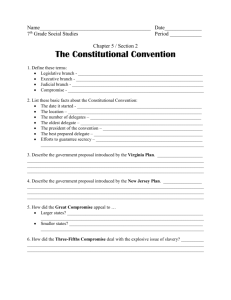
The Founding
And The Constitution: Part Two
© 2013 The McGraw-Hill Companies, Inc. All Rights Reserved.
Starting Over: The Constitutional
Convention
• Prelude: Virginia called for a convention to discuss a
uniform regulation of commerce.
• Only five states sent delegates to this convention in Annapolis, MD.
• Alexander Hamilton (resolution to convene Constitutional Convention to
revise the Articles)
• James Madison (The Vices of the Political System of the United States)
• Constitutional Convention
• Philadelphia 1787
• No Rhode Island; of 74 appointed by states, only 55 delegates attended.
• Motivations of the delegates?
• Charles Beard’s theory: economic interpretation
• Brown and McDonald criticize his theory
2
© 2013 The McGraw-Hill Companies, Inc. All Rights Reserved.
The Delegates
• Bare quorum at opening.
• No more than 11 state
delegations were ever in
attendance at one time.
• Each delegation had one
vote.
• They acted in absolute
secrecy.
3
© 2013 The McGraw-Hill Companies, Inc. All Rights Reserved.
Large States versus Small States: The Virginia
and New Jersey Plans
Virginia Plan
• Edmund Randolph, head of VA
delegation, introduced a plan for
new constitution
• Authored primarily by James
Madison
• 15 draft resolutions that would
establish a strong central
government with three branches: a
bicameral legislature, an executive
and a judicial branch.
• Popular election of one of the two
legislative houses.
• Proportional voting power based on
population (how does the slave
population factor into this?)
4
© 2013 The McGraw-Hill Companies, Inc. All Rights Reserved.
Large States versus Small States: The Virginia
and New Jersey Plans
The New Jersey Plan
• Small states strongly
opposed the VA Plan.
• June 9, William Patterson of
N.J. introduced an
alternative set of proposals.
• Patterson’s proposals
amended, rather than
replaced, the Articles.
5
© 2013 The McGraw-Hill Companies, Inc. All Rights Reserved.
The Three-Fifths Compromise
• Two questions dominated discussion at the
convention:
• Should there be proportional representation in
Congress or equal representation?
• If proportional representation, who would be the
principal upon which to base representation?
• The number of “free inhabitants” in a state?
• What about states with large slave populations?
• Supporters of the Virginia Plan, knew they would
need the southern states’ vote.
• Introduced the Three-Fifths Compromise: Each
slave would count as three-fifths of a person for
purposes of representation.
• This compromise was endorsed by a vote of 9-2,
with only Delaware and New Jersey voting against
it.
• FYI: Note that women, even though they could not
vote, were counted toward the population.
6
© 2013 The McGraw-Hill Companies, Inc. All Rights Reserved.
The Great Compromise
• Convention remained at an impasse over the question of proportional
representation.
• Roger Sherman and Oliver Ellsworth of CT, devised what is called the Great
Compromise.
• Called for a bicameral legislature with a different method for determining
representation in each house AND different procedures for selecting
representatives in each house.
• In the lower house: Representation would be proportional and representatives
would be elected by the people.
• In the upper house (which eventually became the Senate) the New Jersey Plan
would prevail: Representation would be equal (each state would have two
representatives) and Representatives would be selected by state legislatures.
• Debated for 11 days, on June 29th it finally passed.
• Ended the deadlock and shifted debate to other questions.
7
© 2013 The McGraw-Hill Companies, Inc. All Rights Reserved.
Creating the Executive and Judicial Branches
• Executive: Most agreed one was needed.
• Delegates eventually coalesced around the idea of a single chief
executive
• The “president” – based on Latin meaning “to sit at the head of” “to
defend”
• Guardianship rather than aggressive leadership implied;
• Delegates remained concerned regarding powers and selection
• Compromise in this area led to our system of checks and balances;
convention split a number of traditionally executive powers and shared them
with Congress.
• What are some of these powers?
• As to selection and the term of the presidency
• Compromise: president and vice-president selected by an Electoral College
8
© 2013 The McGraw-Hill Companies, Inc. All Rights Reserved.
Creating the Executive and Judicial Branches
• Judiciary: most agreed a system was needed, but should it consist of one
court or a system of courts? How would the judges be selected?
• Created Supreme Court and left it to Congress to decide if others were
needed.
• Judges nominated by the president, but confirmed by the Senate.
• Federalism: balanced needs of strong government advocates with states’
rights advocates
9
© 2013 The McGraw-Hill Companies, Inc. All Rights Reserved.
Articles of Confederation
Designed to protect state sovereignty
Weak, unicameral legislature
No executive or judicial branch
Only had the powers expressly delegated to it by the states; all other
powers reserved to the states.
• Delegates to the Confederation Congress were appointed by the state
legislature.
•
•
•
•
• Each delegation had a single vote (based on majority of delegates; if no
majority, then it must abstain)
• Passage of legislation required 9 of 13 votes.
• Amendment of the Articles required a unanimous vote.
10
© 2013 The McGraw-Hill Companies, Inc. All Rights Reserved.
The Constitution
11
12
© 2013 The McGraw-Hill Companies, Inc. All Rights Reserved.
© 2013 The McGraw-Hill Companies, Inc. All Rights Reserved.
The Articles of the Constitution
• Preamble: justification for the Constitution and its fundamental goals
• “to form a more perfect Union”
• establish justice and “secure the blessings of Liberty”
• Established by “We the people” and not the states, as under the Articles
• First three articles establish and describe the powers of the three
branches of the federal government.
• The remaining articles focus on federal-state relations, relations
among the states, and provide procedures for ratifying the
Constitution and amending it.
13
© 2013 The McGraw-Hill Companies, Inc. All Rights Reserved.
Article 1: The Legislative Branch
Enumerated
Powers
Powers specifically listed in
Article 1, Section 8
17 clauses that contain
specific powers given to
Congress
Impose and collect taxes
Borrow money
Regulate commerce
Declare war
Implied
Powers
Authorized by the necessary
and proper clause of Article I,
Section 8, Clause 18
Expands the enumerated
powers
Congress has the power to
“make all Laws which shall be
necessary and proper for
carrying into Execution the
foregoing powers, and all other
Powers vested by this
Constitution in the Government
of the United States, or in any
Department or Officer thereof.”
Powers withheld
from States
Final section of Article 1
States are forbidden to
enter into treaties with
foreign nations, coin
money, or impose duties
on imports and exports
without the consent of
Congress.
14
© 2013 The McGraw-Hill Companies, Inc. All Rights Reserved.
Article II: The Executive Branch
Vests executive authority in and
enumerates specific powers of the
president.
•
•
•
•
•
•
•
•
•
Serving as commander-in-chief of the armed forces
Granting pardons
Negotiating treaties
Appointing specific officials with the advice and
consent of the Senate.
Details the electoral college
Requires the state of the union
Make recommendations to Congress on measures
deemed necessary and expedient
“take Care that the Laws be faithfully executed”
Also provides guidelines for president’s
impeachment and removal from office.
15
• Shortest of the articles.
• Creates the Supreme Court
• Judges will hold office “during good behavior” – life tenure unless
impeached.
© 2013 The McGraw-Hill Companies, Inc. All Rights Reserved.
Article III: The Judicial Branch
• Judicial independence
• Postponed the decision of expanding judiciary beyond the Supreme
Court
• Left it to the states via Congress by giving them the authority to establish
lower federal courts if they chose to do so.
16
• Article IV: deals with states and their relations
• Full faith and credit
• Article V: details the processes by which the Constitution can be
amended
• Article VI: supremacy clause, forbids the use of any religious test as a
qualification for holding any office, and guaranteed the debts incurred
by the Confederation would be honored under the Constitution.
• Article VII: procedure for ratifying the Constitution
© 2013 The McGraw-Hill Companies, Inc. All Rights Reserved.
Articles IV-VII
17
Nine of thirteen state convention votes were needed to ratify. Debate ensued.
Process took two and half years. Articles of Confederation in place during that time.
Federalists
Anti-Federalists
• Supporters of stronger
national government
• Began with upper hand in
the debate: Articles were a
failure.
• Federalist Papers
• Preferred power remain
with the states
• Distrustful of new and
unfamiliar central authority
• Brutus and Cato and other
pseudonyms
• 85 articles: Publius
• Madison, Hamilton and Jay
• Dense and erudite; did not
move masses, but did move
elites
• Focused on dangers of
centralized power; potential to
become despotic
• Lacked a bill of rights
© 2013 The McGraw-Hill Companies, Inc. All Rights Reserved.
Ratifying the Constitution
18
19
© 2013 The McGraw-Hill Companies, Inc. All Rights Reserved.
• Delaware: first to ratify Constitution (December 1787)
• PA, NJ, GA, and CT quickly followed.
• MA stopped its momentum with concern over the question of the
rights of the people. Would they be protected?
• George Mason (VA delegate) has proposed this during the
Constitutional Convention and was voted down by a majority.
© 2013 The McGraw-Hill Companies, Inc. All Rights Reserved.
Another Compromise: A Post-Ratification
Bill of Rights
• They asserted that the Constitution did not empower the government to
infringe upon those rights, so no bill of rights was necessary.
• This upset Mason so much he did not sign the Constitution, and later
would oppose its ratification.
20
• Federalists conceded and promised that a bill of rights would be
added post-ratification.
• This helped win nine states to ratification.
• Four states still remained opposed: VA, NY (very important states and
thought to be key to the nation’s success)
• In VA, the Anti-Federalist Patrick Henry and Federalist James Madison
debates provided a defining moment in the fight.
© 2013 The McGraw-Hill Companies, Inc. All Rights Reserved.
Another Compromise: A Post-Ratification
Bill of Rights
• Madison moved the state to ratify with his point-by-point rebuttal of Henry’s
criticisms.
• NC did not ratify until November 1789 (after Washington was sworn in as
the first U.S. president)
21
• Much easier to amend the Constitution than the Articles, but not so
easy that amendments would overwhelm the document.
• Constitution has lasted a long time and seen relatively few
amendments.
• Why so stable? Ambiguity allows for flexibility in interpretation.
© 2013 The McGraw-Hill Companies, Inc. All Rights Reserved.
Amending the Constitution
22
© 2013 The McGraw-Hill Companies, Inc. All Rights Reserved.
The Formal Amendment Process
23
Judicial Interpretation
• Judicial review: striking
down acts of government
that violate the
Constitution.
• Ability of Court to adjust
its interpretation
Congressional Interpretation
Presidential Interpretation
• Coordinate construction:
ability of Congress and
Executive to interpret the
Constitution.
• Congress must be mindful of
constitutional limitations, but
may also influence the
understanding of those
meanings.
• In recent years, executive
coordinate construction has
taken the form of presidential
signing statements.
• Allows the president to sign
the bill but express his belief
that one or more parts of it
are unconstitutional.
© 2013 The McGraw-Hill Companies, Inc. All Rights Reserved.
Informal Methods of Constitutional Change
24
• Words in a constitution not enough to guarantee liberty or the
rule of law.
• What else is needed?
• Enforcement
• If not enforced, then the words are ineffective.
• Example: African Americans denied fundamental rights such
as the right to vote long after constitutional amendments
were passed that gave them freedom, equal protection and
citizenship, and the right to vote.
© 2013 The McGraw-Hill Companies, Inc. All Rights Reserved.
Enforcing the Constitution
25






